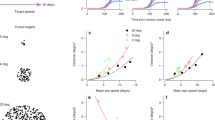In this paper we show how to separate the slow and fast dynamics of the disparity convergence of the eye movements dynamic model. The dynamic equations obtained determine the modified slow dynamics that takes into account the impact of the fast dynamics and the modified fast dynamics that takes into account the impact of the slow dynamics. The slow fast decoupling is achieved by finding analytical solutions of the transformation equations used. The transformed slow and fast subsystems have very simple forms. Having separated the slow and fast dynamics completely, neural control problems for the slow and fast eye movements dynamics can be independently studied and better understood.





Similar content being viewed by others
REFERENCES
Alvarez, T. L., J. L. Semmlow, and W. Yuan. Closely-separated, fast dynamic movements in disparity vergence. J. Neurophysiol. 79:37–44, 1998.
Alvarez, T. L., J. L. Semmlow, W. Yuan, and P. Munoz. Dynamic details of disparity convergence eye movements. Ann. Biomed. Eng. 27:380–390, 1999.
Alvarez, T. L., J. L. Semmlow, W. Yuan, and P. Munoz. Disparity vergence double responses processed by internal error. Vis. Res. 40:341–347, 2000.
Alvarez, T. L., J. L. Semmlow, W. Yuan, and P. Munoz. Comparison of disparity vergence system responses to predictable and non-predictable stimulations. Curr. Physiol. Cogn. 21:243–261, 2002.
Chang, K. Singular perturbations of a general boundary value problem. SIAM J. Math. Anal. 3:520–526, 1972.
Gamlin, P., and L. Mays. Dynamic properties of medical rectus motoneurons during vergence eye movements. J. Neurophysiol. 67:64–74, 1992.
Horng, J., J. L. Semmlow, G. Hung, and K. Ciuffreda. Initial component control in disparity vergence: A model-based study. IEEE Trans. Biomed. Eng. 45:249–257, 1998.
Hung, G. Dynamic model of the vergence eye movement system: Simulations using MATLAB/SIMULINK. Comput. Methods Programs Biomed. 55:59–68, 1998.
Hung, G., and K. J. Ciuffreda (eds.). Models of the Visual System, Chap. 9, New York: Kluwer Academic/Plenum, 2002.
Hung, G. K., J. L. Semmlow, and K. J. Ciuffreda. A dual-model dynamic model of the vergence eye movement system. IEEE Trans. Biomed. Eng. 33:1021–1028, 1986.
Khosroyani, M., and G. K. Hung. A dual-mode dynamic model of the human accommodation system. Bull. Math. Biol. 64:285–299, 2002.
Kokotovic, P., H. Khalil, and J. O’Reilly. Singular Perturbation Methods in Control: Analysis and Design. Orlando, FL: Academic, 1986.
Munoz, P., J. L. Semmlow, W. Yuan, and T. L. Alvarez. Short-term modification of disparity convergence eye movements. Vis. Res. 39:1695–1705, 1999.
Robinson, D. A. The mechanics of human saccadic eye movement. J. Physiol. 17:245–264, 1964.
Semmlow, J. L., W. Yuan, and T. L. Alvarez. Evidence for separate control of slow version and vergence eye movements: Support of Hering's law. Vis. Res. 38:1145–1152, 1998.
Semmlow, J. L., W. Yaun, T. L. Alvarez. Short-term adaptive control processes in vergence eye movement. Curr. Physiol. Cogn. 21:343–375, 2002.
Szidarovszky, F., and A. Bahil. Linear Syst. Theory. Boca Raton, Florida: CRC, 1992.
Van Opstal, A. J., A. M. van Gisbergen, and J. J. Eggermont. Reconstruction of neural control signals for saccade based on an inverse method. Vis. Res. 25:789–801, 1985.
Yuan, W., J. L. Semmlow, T. L. Alvarez, and P. Munoz. Dynamics of the disparity vergence step response: A model based analysis. IEEE Trans. Biomed. Eng. 46:1191–1198, 1999.
ACKNOWLEDGMENT
The author is thankful to Professor George Hung from Rutgers University, Department of Biomedical Engineering, for providing useful clarification of the considered vision system dynamic model and an interpretation of the roles of its slow and fast components.
Author information
Authors and Affiliations
Corresponding author
Rights and permissions
About this article
Cite this article
Radisavljevic-Gajic, V. Slow-Fast Decoupling of the Disparity Convergence Eye Movements Dynamics. Ann Biomed Eng 34, 310–314 (2006). https://doi.org/10.1007/s10439-005-9042-0
Received:
Accepted:
Published:
Issue Date:
DOI: https://doi.org/10.1007/s10439-005-9042-0




